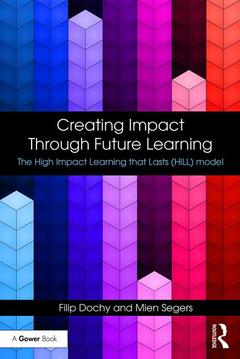Creating Impact Through Future Learning The High Impact Learning that Lasts (HILL) Model
Auteurs : Dochy Filip, Segers Mien

Organisations today operate in a fascinating world where change is constant, fast and continues to accelerate. It is the combination of evolving developments such as technological advancements, globalisation and new ways of communicating through multimedia technologies that drive us to reorganise how we live, how we work, how we create value, and how we learn. These developments call for a Learning & Development policy and practice that supports professionals to be or become successful in this fascinating changing world. In other words: one of the core goals of Learning & Development is to support sustainable employability.
Creating Impact through Future Learning introduces a model for High Impact Learning that Lasts (HILL) that is very much in synch with the demands of an agile organisation. The HILL model is about the learning of young adults, professionals, and experts. It is about the many possibilities to inspire and to support adults in their continuous learning and development process, aiming to create value for today?s and tomorrow?s society. It is about how designers of learning programmes ? be it L&D officers or teachers in vocational and higher education preparing adults for professional life ? can take a step forward to build the future of learning. A new mindset is needed to create a real impact.
List of Figures, Chapter 1. THE FUTURE OF LEARNING - INTRODUCTION, High Impact Learning that Lasts, Recent Developments in the Learning Society, The Labour Market and Generic Competences, Using Information Technology, The Crossroad Where We Are Now, How New is our Current View on Learning? The Way to High Impact Learning that Lasts (HILL). Chapter 2. AN EXECUTIVE SUMMARY OF THE HILL–MODEL: HIGH IMPACT LEARNING THAT LASTS, The Core of the HILL Model, A One Sentence Explanation of Learning in 2040, How to Read the Model / How Does it Look? In What Ways is the HILL Model Relevant to You? Chapter 3. SCIENTIFIC BACKGROUND OF HILL, Building Block 1: Urgency, Gap, Problem, Building Block 2: Learner Agency, Building Block 3: Collaboration and Coaching, Building Block 4: Hybrid Learning, Building Block 5: Action and Knowledge Sharing, Building Block 6: Flexibility – Formal and Informal Learning, Building Block 7: Assessment-As-Learning, Chapter 4. THE HILL-MODEL IN PRACTICE: TIPS AND GUIDELINES, Urgency, Gap, Problem, Learner Agency, Collaboration & Coaching, Hybrid Learning, Action & Knowledge Sharing, Flexibility – Formal & Informal Learning, Assessment As Learning, Chapter 5. WHY CAN THEY DO WHAT WE CANNOT? TEN SECRETS OF FUTURE LEARNING IN TOP TRAINING PROGRAMMES, 10 Key Boosters, Reaching these 10 Goals in your Organisation, Chapter 6. APPLICATIONS OF HIGH IMPACT LEARNING THAT LASTS, Case 1: Scientor N.V. & Scientor Academy: An Application Of High Impact Learning That Lasts, Case 2: How To Support Lifelong Learning That Is On-Demand And Just-In-Time? A Case From The Technology Sector, REFERENCES, Index
Filip Dochy is Professor of Corporate Learning & Development in organisations and education at the University of Leuven, Belgium. His research focusses on Learning & Development in organisational and professional education, learning and working in teams, virtual teams, competence-based learning, team-coaching, and the practical implementation of HILL
Mien Segers is Professor of Corporate Learning at the Maastricht University School of Business and Economics, the Netherlands. Her research focusses on addressing workplace learning, aiming to provide insights on antecedents, determinants as well as effects in terms of employability and Innovative Work Behaviour.
Date de parution : 02-2018
15.6x23.4 cm
Date de parution : 02-2018
15.6x23.4 cm
Thèmes de Creating Impact Through Future Learning :
Mots-clés :
High Impact Learning; Hybrid Learning; Learner Agency; HRD; Problem Based Learning; Learning & Development; Knowledge Transfer Tools; Impact; Lifelong Learning Trajectories; Impact of learning; Learning Trajectories; Training; Knowledge Acquisition; Transfer of training; Long Term Recommendations; effectiveness of training; Support Lifelong Learning; corporate training; Van Den Bossche; corporate learning; Formal Management Roles; professional learning; Informal Learning Activities; workplace learning; Lifelong Learning Initiatives; workbased learning; Smart Factories; competitive advantage; CPSs; personal development; Feedback Dialogue; professional development; Knowledge Acquisition Phases; Mien Segers; Review Journals; ILE; Informal Learning; Group Potency; Similar Personal Values



